ASRock Fatal1ty Z77 Professional Review - IDE and Floppy on Z77
by Ian Cutress on May 20, 2012 1:30 PM EST- Posted in
- Motherboards
- ASRock
- Fatal1ty
- Z77
USB Speed
For this benchmark, we run CrystalDiskMark to determine the ideal sequential read and write speeds for the USB port using our 240 GB OCZ Vertex3 SSD with a SATA 6 Gbps to USB 3.0 converter. Then we transfer a set size of files from the SSD to the USB drive using DiskBench, which monitors the time taken to transfer. The files transferred are a 1.52 GB set of 2867 files across 320 folders – 95% of these files are small typical website files, and the rest (90% of the size) are the videos used in the Sorenson Squeeze test.


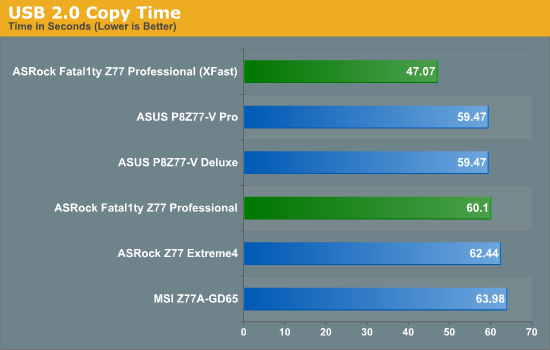
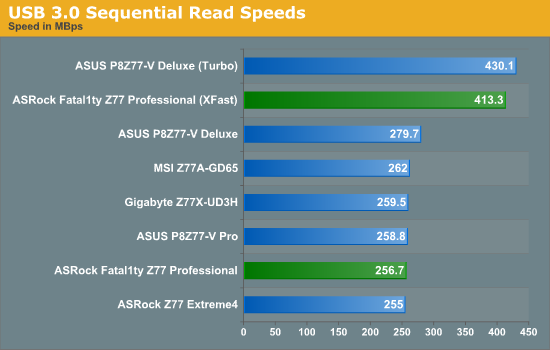
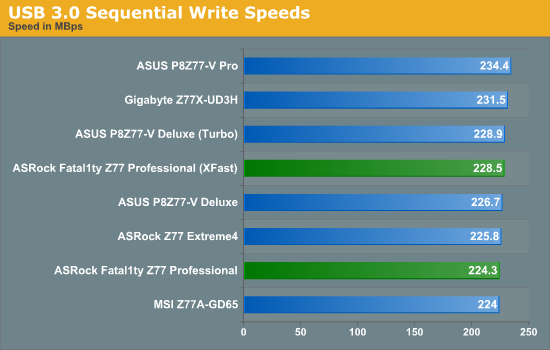

While the XFast implementation clearly makes the ASRock pull ahead of all the standard solutions of other motherboards, the default performance of the ASRock is a little disappointing. The USB 2.0 results in particular, as all the other manufacturers have at least another 1 MBps read speed on the ASRock implementation.
SATA Testing
We also use CrystalDiskMark for SATA port testing on a C300 drive. The sequential test (incompressible data) is run at the 5 x 1000 MB level. This test probes the efficiency of the data delivery system between the chipset and the drive, or in the case of additional SATA ports provided by a third party controller, the efficiency between the controller, the chipset and the drive.
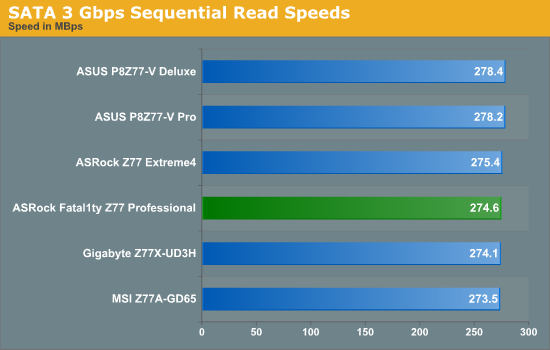
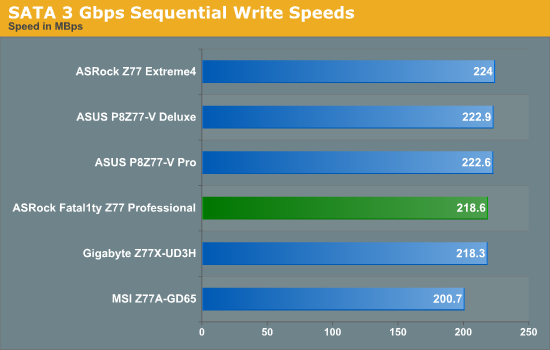
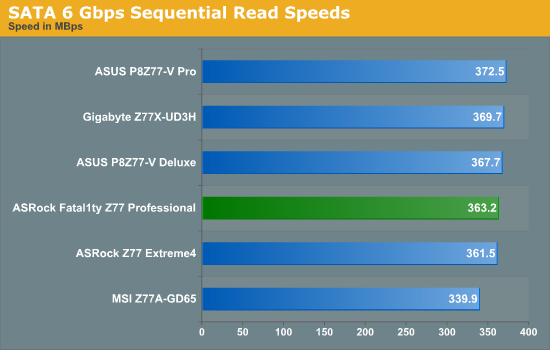
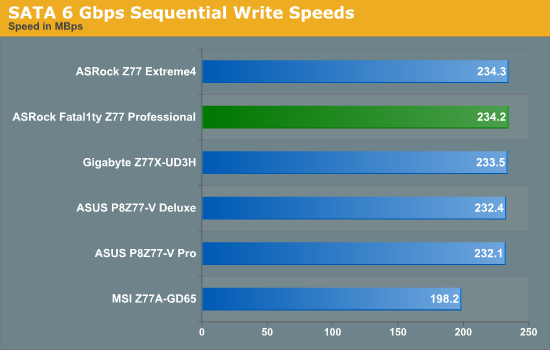
Nothing much to compare with regards to the SATA implementations between the boards.
DPC Latency
Deferred Procedure Call latency is a way in which Windows handles interrupt servicing. In order to wait for a processor to acknowledge the request, the system will queue all interrupt requests by priority. Critical interrupts will be handled as soon as possible, whereas lesser priority requests, such as audio, will be further down the line. So if the audio device requires data, it will have to wait until the request is processed before the buffer is filled. If the device drivers of higher priority components in a system are poorly implemented, this can cause delays in request scheduling and process time, resulting in an empty audio buffer – this leads to characteristic audible pauses, pops and clicks. Having a bigger buffer and correctly implemented system drivers obviously helps in this regard. The DPC latency checker measures how much time is processing DPCs from driver invocation – the lower the value will result in better audio transfer at smaller buffer sizes. Results are measured in microseconds and taken as the peak latency while cycling through a series of short HD videos - under 500 microseconds usually gets the green light, but the lower the better.

The DPC timings on Ivy Bridge are exceptional – not one board has yet achieved slower than 120 microseconds. The Fatal1ty puts in a good show, just missing out on a sub 100-microsecond timing.










57 Comments
View All Comments
Senti - Monday, May 21, 2012 - link
Hell yes to IDE port. It was very frustrating to find on my new motherboard no IDE but "great" SATA 6 was there. Marvell, 2 SATA 6 ports on single PCI-E 2.0 line. Who sane would use that instead of integrated Intel RST plain SATA 3? IDE controller would be way, way more useful.The same story with PCI slots on new boards: we get 0 PCI and 7 PCI-E. But hey, if you plug something in slot X then Y won't work, or if this 1x slot is used then that 4x would become 1x. How about providing fully supplied (or at least more supplied) PCI-E ports and filling space left with PCI?
hechacker1 - Monday, May 21, 2012 - link
Yeah I like the IDE port, even if I'm going to rarely use it. They might as well shrink the header and give us a breakout cable to save space.I guess with USB 3.0, they could just give us an IDE to USB cable and solve the problem.
mapesdhs - Tuesday, May 22, 2012 - link
This is why I kept buying Asrock boards, the slot layout and choice was excellent,
eg. the P55 Deluxe is really good (I have several). Loved the 3-slot spacing for
SLI/CF, has floppy/IDE (I use SAS RAID cards which usually need a floppy for
BIOS/fw updates, and I was carrying over an IDE DVDRW), good price. Infact I
didn't think Asrock's P67 boards were as good as the P55 Deluxe.
The exception is my P67 board, an ASUS Maximus IV Extreme, because I got it for
a very low price refurb, otherwise I would likely have bought a Z68 Extreme4.
Ian.
silverblue - Monday, May 21, 2012 - link
...ATi logo on the board adjacent to the top PCI port.IanCutress - Tuesday, May 22, 2012 - link
We actually see that on a lot of boards still. Perhaps it's time for a design update :)Ian
hardslime - Monday, May 21, 2012 - link
"There are six fan headers on the board – the CPU socket has two fan headers above the top heatsink, one 4-pin and one three-pin, and two above the first PCIe x1 slot (both are three pin). Other fan headers on board are at the bottom, where we find two three-pin chassis headers."One of the chassis headers is a 4-pin. I own this board, you can also see it in some of the pictures.
Matt355 - Monday, May 21, 2012 - link
They should remove the Gamer tag and brand this as what it is, a Home Server Motherboard. 10 SATA ports, IDE, Floppy, lots of fan headers, PIC slots. Not what most Gamers are looking for but it still might sell to the home server crowd.faster - Monday, May 21, 2012 - link
Gamers are hardcore competitive. There is no way I'm going to copy the setup of someone I want to beat. I'm going to do my research and build a better system to try and squeeze out those extra framerates to give me the edge.I build a lot of systems and I have never bought a "Wendel" component and I probably never will unless it clearly beats the competition, something I have never seen from a Wendel component.
ocyl - Tuesday, May 22, 2012 - link
The fact that ASRock Fatal1ty Z77 Professional has built-in IDE and floppy connectors is one of the primary reasons why I will purchase this motherboard rather than the others in the same price range. Sure, I may never need to use these connectors again after the next system migration, but if/when I ever do in the future, I won't have to spend any additional money on expansion cards, nor will I need to allocate any PCI (Express) slot or USB port for them.On the other hand, I would have liked to see dual-link DVI, DisplayPort, and D-sub, or at least dual-link DVI and DisplayPort, instead of DisplayPort and HDMI, video output connectors on this motherboard. I have invested a lot of money in professional-grade monitors, and I am not going to swap them out simply because they are equipped with DVI connectors. Passive DisplayPort-to-DVI and HDMI-to-DVI adapters can only output single-link DVI signals.
jigglywiggly - Tuesday, May 22, 2012 - link
i have better aim that fatal1tyhttp://www.youtube.com/watch?v=on1dT4lLuWA
i have a frag of him somewhere, and every game i've played with him, my lg and rail accs are always better, 1.5x.
I still want his stuff, he is p cool, and a great dueler.
Wat u r describing is a lozer